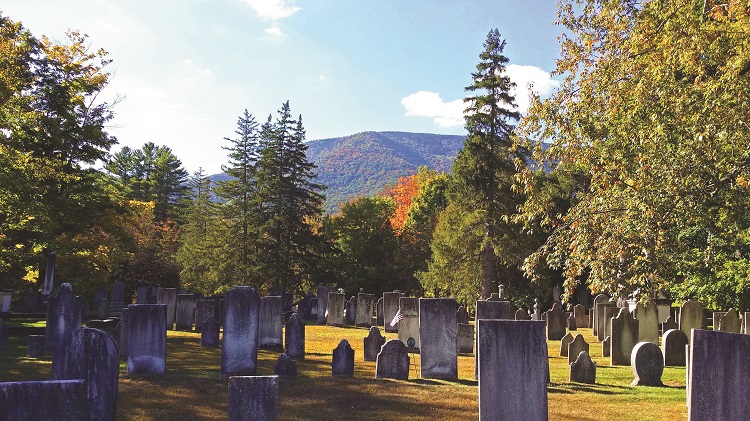Is Dellwood Cemetery historic Manchester’s most romantic landscape?
By Anita Rafael
Principal Photography By Hubert Schriebl
The story of Dellwood Cemetery on Main Street in Manchester Village begins with the story of what happened to another older burial ground that was established in the earliest years of the town’s settlement. The oldest headstones that are now in Dellwood stood someplace else long before this beautiful 19th-century cemetery was designed.
It is possible that there are only a handful of local residents who know the true story of what lies below the basement of the Northshire’s Bennington County Courthouse, across from the historic Equinox Hotel. The land where the brick-built courthouse was built in 1822 was once a graveyard, and it holds a secret.
When the town of Manchester was first laid out in 1784, its founders measured out a two-acre parcel in the center of the village. It was known then as “the meeting house lot,” intended for a meetinghouse and a schoolhouse. The remaining space was set aside for burials. In time, the graveyard became neglected. Before 1812, some of the smaller stones, tilted and spalled, had been removed to clear a parade ground for the local militia. So, when the proposal was made to relocate all the old graves to make room for a new courthouse building, a large, important edifice that would add prestige to the village center, the idea made sense.
But here’s the secret: hardly any of the remains were removed from the site. Just the headstones were taken away, carted just a half-mile south along Main Street and set close together on a small knoll by the side of the road. At the edge of farmland, no gate, no fence, and no sign marked the new burial ground. This small graveyard would, a generation later, become a treasured part of the beautiful, park-like Dellwood Cemetery laid out around it. The rest of the story is not the least bit spine tingling, and frankly, it’s altogether enchanting in a romantic 19th century sort of way.
“The main avenue, commencing at the entrance, winds artistically over the more elevated ground to the valley beneath… . There are also many smaller avenues or walks for pedestrians only, and these are probably unsurpassed in the country, winding as they do under the thick spreading branches of Birch, Beech, Elm, Maple and Spruce, and in addition being within the sound of the clear rippling brook of mountain spring water which runs through the entire length… .”
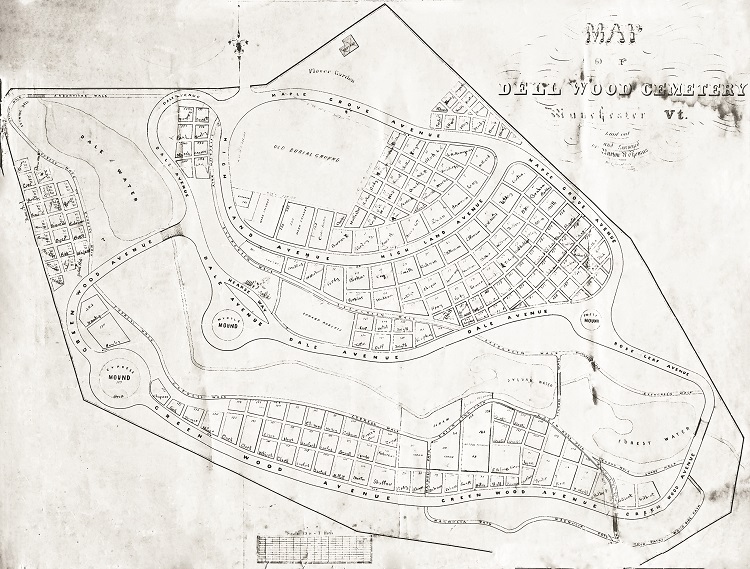 Original 1865 survey of Dellwood Cemetary by Burton A. Thomas of West Sand Lake, NY. Manchester Historical Society
Original 1865 survey of Dellwood Cemetary by Burton A. Thomas of West Sand Lake, NY. Manchester Historical Society
How does this not seem like the most scenic and most desirable parcel of real estate in all of Manchester? If no one told you that was the description Park and Cemetery Journal, vol. 5, May 1895, in Chicago, you’d think it was an advertisement for prime residential property or an exclusive country club.
Incorporated and improved in 1865, and later enlarged, Dellwood has always been a private cemetery association. The additional acreage was bought with donations from wealthy benefactors, among them Judge Mark Skinner, a Manchester native and a noted Chicago jurist, and Judge Helmus M. Wells from New York. Both had lived in Manchester and returned seasonally. Judge Skinner, who later gave a generous endowment for Dellwood, is buried there.
Entering the gates with the two marble statues (imported from Italy, they are identified as the angel Gabriel and “The Mourner”), the tight cluster of headstones in perfectly straight rows just ahead and to the left, set on a slight rise, include the ones that had been relocated from the burial ground in the village center. Look for a headstone with a hat on top. It’s easy to spot since it’s the only one like it. That is the grave of Manchester-born Lt. Colonel Charles Dudley. The cap, as Civil War buffs know, is a kepi, and the inscription on the monument tells the young officer’s poignant story. “That is one of my favorite headstones,” says, Dellwood’s superintendent Kurt Baccei. He has been at Dellwood for 20 years now, working alongside just one other employee to maintain the entire property. Long ago, it took a crew of six landscapers and gardeners to maintain the grounds and to tend a large greenhouse, now gone, which sold fresh flowers and plants.
People silently hope, especially around the coming holiday that calls forth all manner of spirits and specters, that some part of Dellwood’s 58 acres would offer up a gruesome ghost story or a bloody vampire tale, a haunting so menacing in the telling that everyone would shiver just passing by the cemetery gates in broad daylight. But Dellwood Cemetery is and always has been superbly cared for, and it is so picturesque, so peaceful, and so like Paradise, that it belies its mournful purpose as a colony of the dead. At times it has been one of the most popular attractions in the village. Throughout the late 1800s and well into the 20th century, Manchester residents regularly brought their friends and guests to Dellwood to show off the cemetery as a matter of civic pride, a place equally as prized as a scenic public park, an exotic zoo, or a fancy opera house.
Among all classes of society, people visited these “modern” cemeteries, which were being professionally landscaped all throughout the nation, and which were then a total novelty. Men, women, and children went to Dellwood for picnics and garden parties, of a sort. In spring, on Decoration Day, and on nice summer days, people merrily gathered to plant masses of flowers in the huge, cast-iron urns (which are still there) and to beautify the graves. They lingered on to chat and relax a bit amidst the family’s monuments, as well as to enjoy the beautiful panoramic view toward the mountains beyond. No one thought the place was even the slightest bit spooky because, well, it wasn’t.
Now, if you had to pick the one possibly ill-omened spot in all of Dellwood Cemetery, it would have to be the Receiving Vault built in 1867. To find it, walk toward the south side of the knoll where the oldest graves are and look for the dark green Civil War cannons—you will see just the barrels of the guns sticking upright on either side of the huge monument of Gen. Benjamin Roberts and his wife. Then, just to the left, look for a steep, dirt path with rough-hewn steps leading straight down through the evergreen trees toward the ravine. Turn right at the bottom, and immediately on your right is a small stone building, protruding from the embankment. It has a weathered wooden door, painted green. No longer used, the chamber is where corpses were kept throughout winter, waiting for burial the moment spring arrived. (Dellwood now digs graves all year round, while many cemeteries still do not. No waiting.)
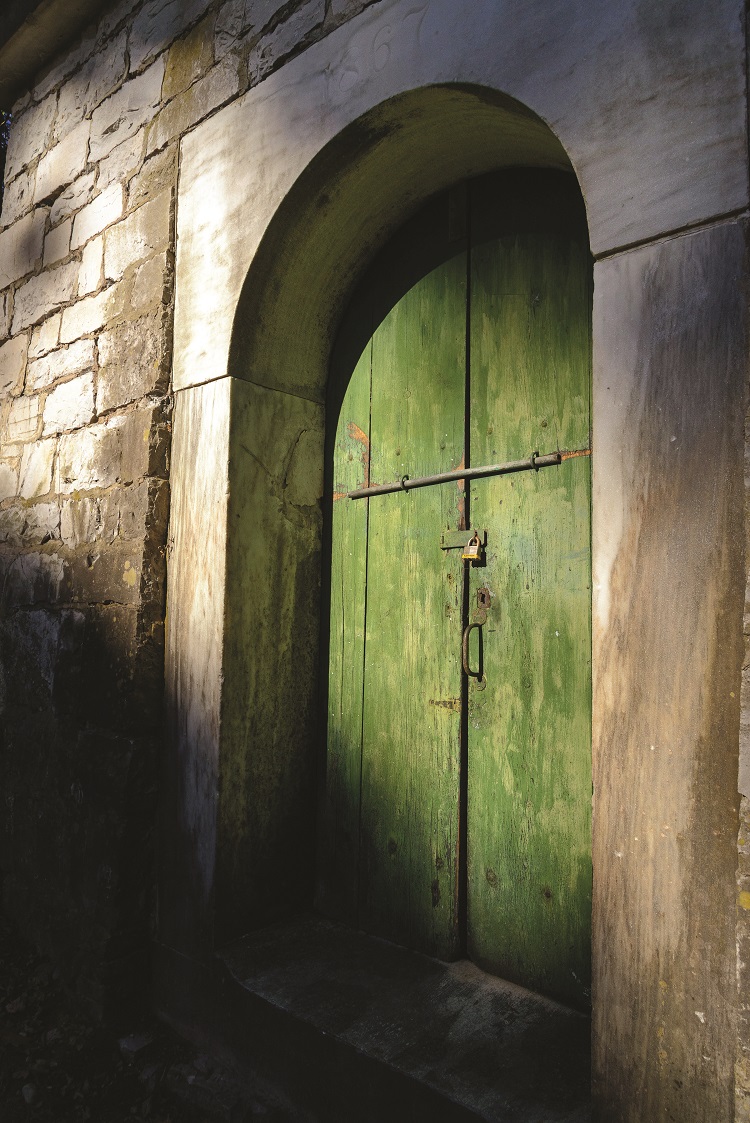
The most notable occupant of the Receiving Vault was the son of President Abraham Lincoln, the esteemed Robert Todd Lincoln. He was Dellwood’s neighbor, and, looking south, you can see that the lane leading to Robert’s estate, Hildene, borders the cemetery. A week shy of his 83rd birthday, Robert died alone in his bed at Hildene during the night of July 26, 1926. In writing, decades earlier, he had expressed his intention for his remains to be placed in the magnificent Lincoln tomb in Oak Ridge Cemetery in Springfield, Illinois, but Robert’s coffin stayed in Manchester in Dellwood’s tiny Receiving Vault for many months while his widow arranged for a plot in Arlington National Cemetery. On the very top of page 121 in the cemetery’s ledger book for 1926 is the following notation in ink in superintendent A.H. Darling’s fine handwriting:
Oct 20 Mr Lincoln’s body removed to Arlington Cemetery Virginia By permission of Board of Health [sic].
The burial in Virginia took place on March 14, 1928, so by that time, Robert had been cold already for 597 days.
Looking at the old vault with its uneven, lichen-splotched stones and the blackening marble on its doorframe, you cannot help but wonder just for a teeny-weeny moment: If Dellwood was to have a ghost, would it be in there?
Dellwood has its share of VIPs, including the daughter of the American oil tycoon John D. Rockefeller. She lies beneath a rather modest headstone in Dellwood Cemetery. If you walk on the paved lane keeping the ravine on your left almost to where the dark green maintenance shed sits, over on the right side you will see the large Prentice memorial. The gravesite of Alta Rockefeller Prentice (B. April 12, 1871, Cleveland, OH; D. June 21, 1962, New York, NY; aged 91) is next to her husband’s, tucked under an 8-foot-high lilac bush.
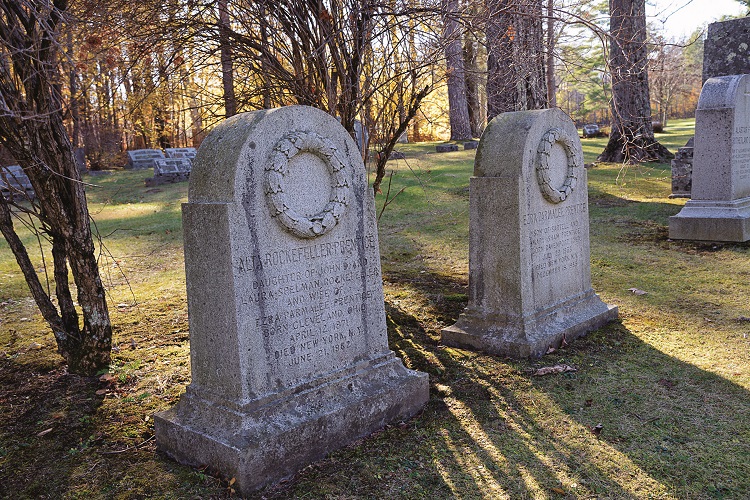
In January 1901, the heiress-in-waiting married a Chicago attorney, Ezra Parmalee Prentice, right after The New York Times printed a somewhat gossipy society-page notice that the wedding was off while Alta was in Vienna, Austria, undergoing “a remarkable operation for the relief of deafness.” (The Times printed a second item one week after the first one that stated that friends of Mr. Prentice and friends of the Rockefeller family declared that the earlier announcement was based on information that was “wholly untrue.”)
Widowed in 1955, and having dedicated much of her life’s work to giving away a great deal of money to many worthy causes, including gifts to many Manchester charities and the Dellwood Cemetery Association, she nonetheless left an estate worth more than $12 million upon her death. Alta was the last surviving child of Rockefeller, and just FYI, she was Vice-President Nelson Rockefeller’s aunt.
Miss Icy Palmer’s fame, on the other hand, may not have spread far beyond Manchester, but she has become a legendary figure in the town’s history. Her gravesite is not hard to find, if you know where to look. Walk over to the wooden gate in the hedges directly behind the stone-built house, formerly the cemetery’s Superintendent’s Cottage and now a private home. Almost in front of the gate, look for a small marble headstone set apart from any others.
Icy was born in September, 1824, and at some point in her life she changed her first name from Louisa. She died on July 9, 1911, at 86. There are few clues as to Icy’s true origins in photographs of her, but it is known that she was of Indian blood and had been born in a sugar house down Muddy Lane in Manchester, and by some accounts, given up or abandoned. (Her birthplace was about where the Equinox Valley Nursery is now, 3½ miles from her final resting place in Dellwood.)
According to Shawn Harrington, curator at the Manchester Historical Society and a trustee of the Dellwood Cemetery Association, “Icy lived in Manchester all her life and made and sold candles as a living. Among the many stories about Icy, one legend contends that every night she lit two candles that burned from dusk until dawn in a ritual of protection and enchantment.” Her tribe, the Tuscarora, likely migrated over several generations, leaving North Carolina for New York in the 19th century and aligning with the Iroquois.
There are now close to 2,000 internments at Dellwood, according to the Dellwood Cemetery Association’s trustees. In a quiet conversation one day near the circle of gravesites of members of the Orvis family, cemetery trustee Shawn Harrington and superintendent Kurt Baccei spoke about how people aren’t dying the way they used to. “There are far fewer burials and more cremations now,” they said. “We do about five or six burials a year.”
The great wave of the Rural Cemetery Movement in America, beginning in the mid-1800s, a time when where and how you were buried was as much of a status symbol as where and how you lived, is long since passed. Yet, Dellwood endures as one of the finest examples of a professionally landscaped cemetery of its era. While no longer quite as much of a cultural attraction as it was a century ago, it is worth remembering that along with perpetual care for the dead who forever sleep in Dellwood comes perennial beauty for the living who care to walk through the gates.
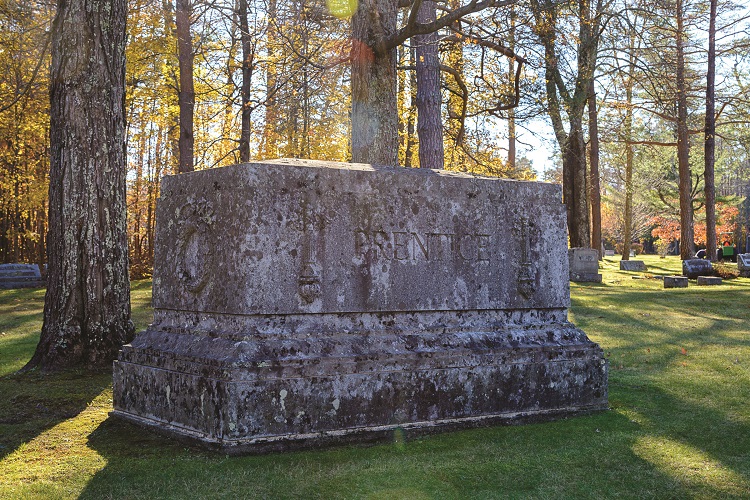
From White To Black
You are looking at acid rain made visible. Yes, even in the pure mountain air of Manchester, there is enough acid rain to cause marble to seriously blacken. It affects gravestones and the marble and limestone used in buildings, too. Due to chemical reactions that happen at the atomic level in the atmosphere, sulfurous gases and sooty pollutants dissolve the surface of marble into black deposits or a gypsum crust. Ever so slowly, every time it rains, “sugared” particles wash away. So, for the scientists in our midst, that chemical reaction is CaCO3 + H2SO4 + H2O → CaSO42H2O + CO2.
A marble gravestone can be made gleaming white again by carefully using the proper cleaning agents and methods, but the fine details that are already pitted and have been eaten off can never be brought back.
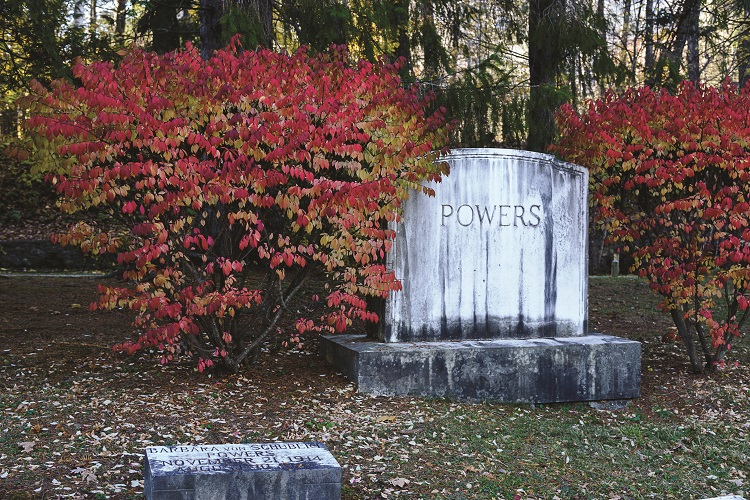
A Walk In The Dell
Dellwood Cemetery is at 2950 Route 7A, one-half mile from the landmark Equinox Hotel on Main Street in Manchester Village. There are no designated parking areas, so just be sure to leave your vehicle where it is not blocking the lanes—you may enter and exit at either of the two gates. Dogs should stay home for this outing. No one will think it’s peculiar for you to be strolling among the gravesites (unless you are doing something peculiar yourself, so don’t.) It’s a perfectly scenic, totally unhaunted spot for an easy, pleasant walk.
To stay informed about guided tours, join the Manchester Historical Society or friend them on Facebook. The trustees of the Dellwood Cemetery Association want everyone to know that the cemetery is very much open for business, and that some of the land within its boundaries is still undeveloped, with many acres for expansion. Who wouldn’t like to spend eternity overlooking one of the pretty little ponds? You get to listen to the sound of the waterfall, watch the wild ducks and geese, and delight in the company of the occasional otter that makes its way up the brook while chasing trout. For details, visit www.dellwoodcemetery.org or call 802-362-1512.
